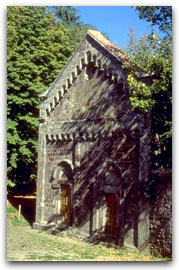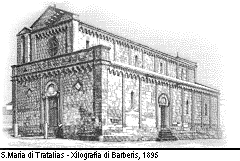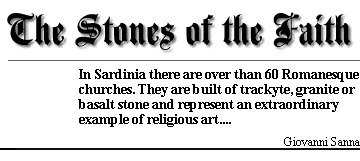These Sardinian churches are
small, simple and uncoloured except for the natural colours of the stone; the red of sandstone,
the black of basalt and the white of limestone. The most beautiful churches are the medieval
ones. After the year 1000 the need to spread the Catholic religion throughout Sardinia started
the most extraordinary architectural development in the history of this ancient island.
Architects, stone masons and decorators were sent to the island by the pope or recruited by
Sardinian judges to build churches. A group of French monks, the Vittorini from Marseilles,
built a chain of churches which represent the clearest evidence of the spread of the Catholic
religion among the Sardinian people.
These churches are monuments of the spirit, the stones of the faith.
|
|

 Cagliari - S. Alenixedda Cagliari - S. Alenixedda |

 Silanus - The church of S. Lorenzo Silanus - The church of S. Lorenzo |
|
In the next 200 years, nearly 70
churches were built all over the Island. Most of them are in the countryside far from the urban
centres. They are art treasures of inestimable value and even if they are not well known they
are well worth visiting. The failure to maintain and protect these treasures, which surely
deserve more protection and recognition, arises from the lack of respect, on the part of
officialdom, for the artistic patrimony they represent and often means that it is difficult gain
entrance into these treasures of Romanesque art.
|
Fortunately, the Sardinians are
very proud of these works of art and are pleased to be able to show people around them. For
this reason the tourist who wants to visit these churches will always find someone able to give
him information and to open the church. It is usually best to ask the parish priest of the village
to open the church you want to visit.
|
| However, as mentioned above, the
tourist must not expect to see imposing monuments or majestic architecture. Sardinian
Romanesque churches can be admired for the opposite reasons. In fact, the poverty of
Sardinia in Medieval times meant that complex buildings could not be built. Therefore the
churches that were built during those years have no more than three naves, none has a dome
or rounded walls. The material used for these buildings was stone and it is useless to look for
marble statues or precious frescos. Sometimes the construction of windows was difficult, so in
most of these Sardinian churches there is not a lot of sunlight, and this creates an atmosphere
of deep spirituality which induces meditation and prayer. |
|

 S. Leonardo de Siete Fuentes S. Leonardo de Siete Fuentes |
|



